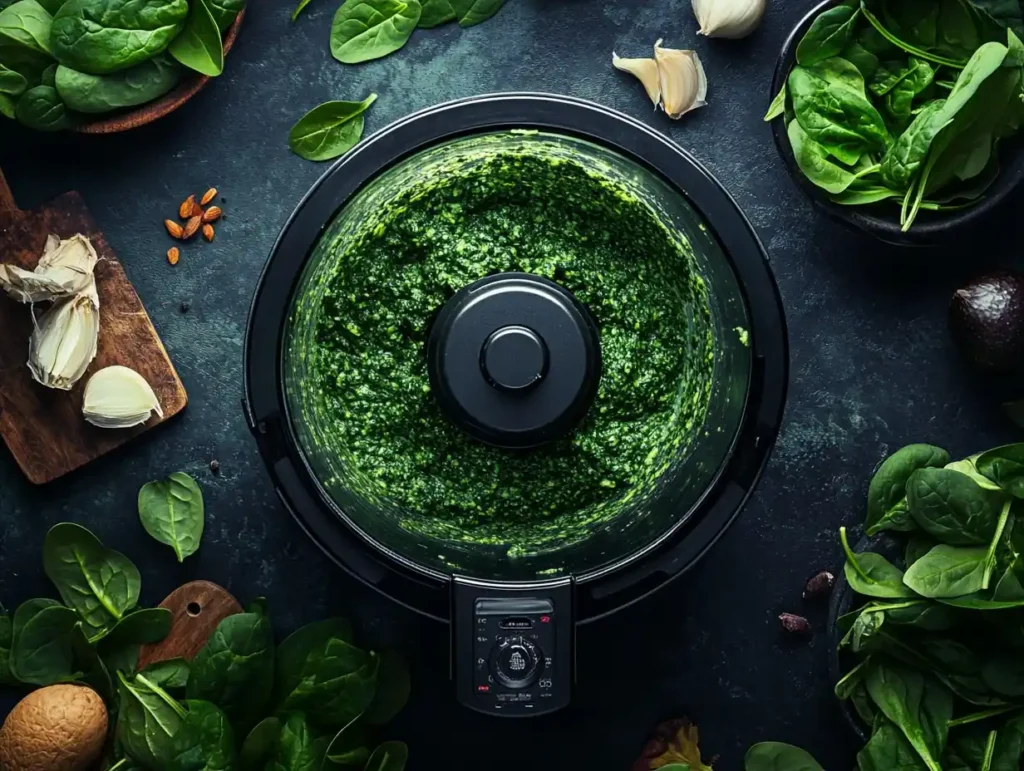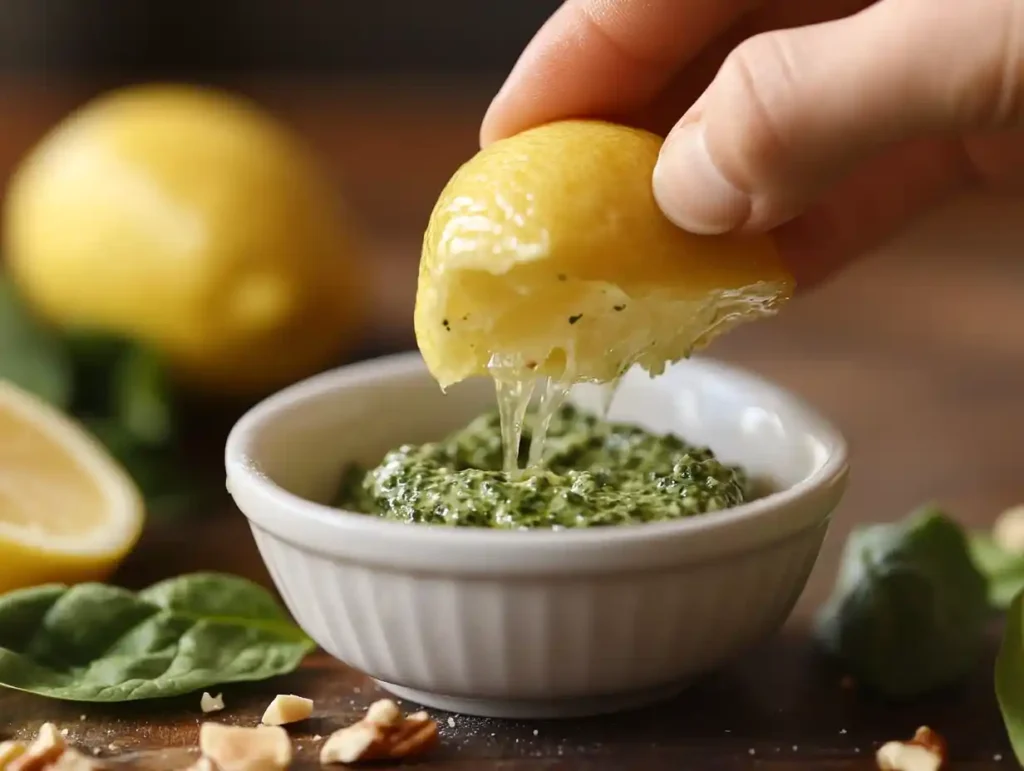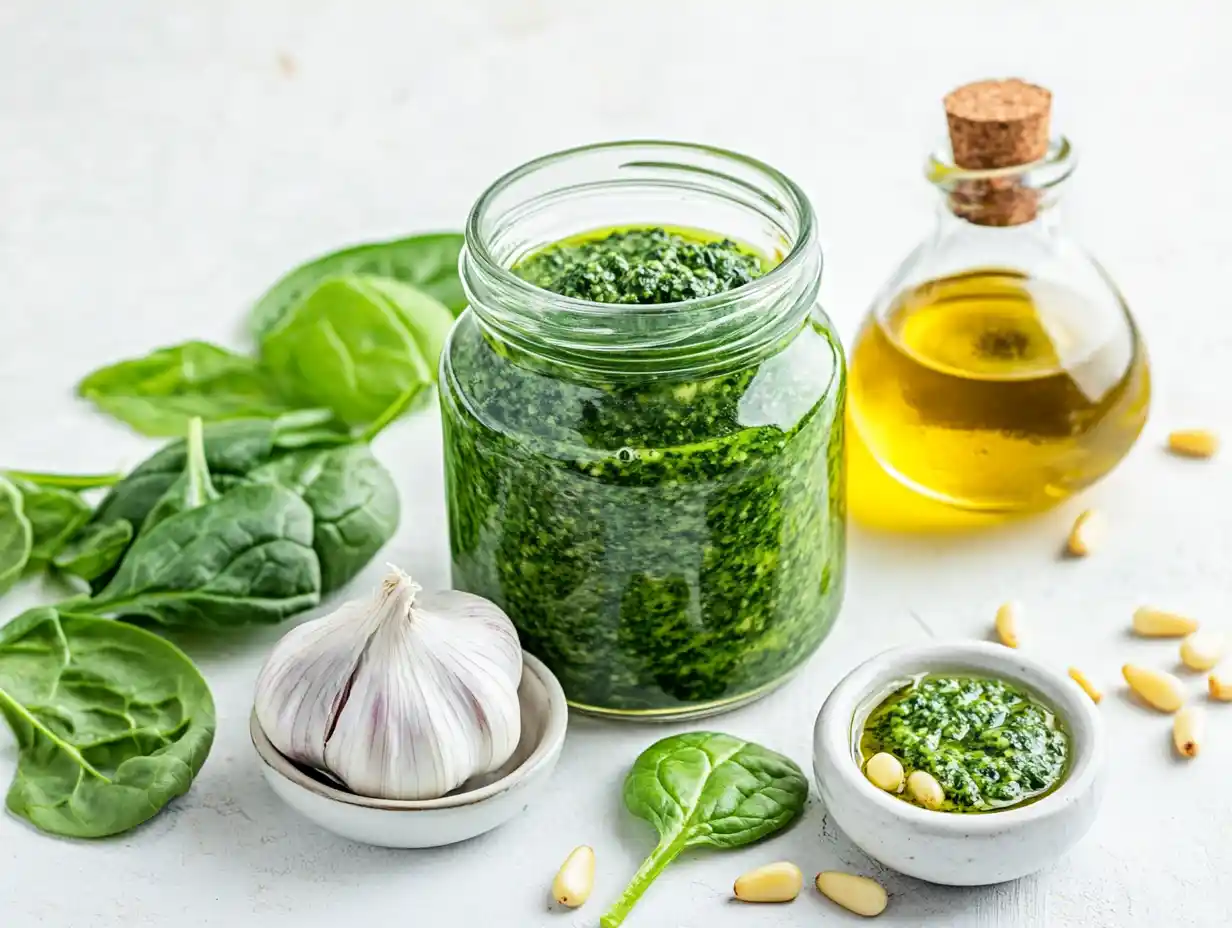Introduction
Spinach pesto is a vibrant, healthy alternative to traditional basil pesto. Its earthy flavor and rich green color make it a go-to choice for pasta, sandwiches, or dips. However, bitterness in spinach pesto can turn an otherwise delicious dish into a disappointment, leaving many asking, “Why is my spinach pesto bitter?”
This issue is more common than you might think. Bitterness often stems from factors like the type of spinach, over-blending, or an overpowering amount of garlic. Even the quality of olive oil or improper storage can contribute to unwanted flavors. While these problems can ruin the taste, they are easy to identify and fix with a few simple adjustments.
In this article, we’ll explore the causes of bitterness in spinach pesto and offer practical tips to solve and prevent it. By understanding the role of each ingredient and refining your technique, you’ll master the art of creating smooth, flavorful pesto every time.
Understanding Spinach Pesto
What Is Spinach Pesto?
Spinach pesto is a vibrant variation of the classic basil pesto. It swaps out basil for spinach, creating a milder, earthy taste. This pesto is often made with fresh spinach, olive oil, garlic, nuts (like pine nuts or walnuts), Parmesan cheese, and sometimes a squeeze of lemon juice.
Its versatility makes it a favorite in many kitchens. You can use it as a pasta sauce, sandwich spread, or even a dip. Plus, it’s a great way to sneak more greens into your meals.
Core Ingredients and Their Roles
Each ingredient in spinach pesto plays a crucial role in its flavor and texture. Let’s break them down:
- Spinach: Provides the base for the pesto, giving it a fresh, mild flavor and bright green color.
- Olive Oil: Adds richness and helps blend the ingredients into a smooth paste.
- Garlic: Gives the pesto a bold kick, balancing the mildness of the spinach.
- Nuts: Bring a nutty, slightly creamy texture. Pine nuts are traditional, but walnuts or almonds work well too.
- Cheese: Parmesan or Pecorino adds a salty, umami depth to the flavor.
- Acid: Lemon juice or vinegar cuts through the richness and brightens the overall taste.
When these ingredients come together, the result should be smooth, savory, and perfectly balanced. However, even one ingredient slightly off can tip the balance and lead to bitterness.
Reasons Behind Bitter Spinach Pesto

Common Causes of Bitterness
If your spinach pesto turns out bitter, one or more factors are likely at play. Here’s a closer look at what might be causing the problem:
The Quality of Spinach
Spinach is naturally earthy, but older or wilted spinach can carry a bitter aftertaste. Baby spinach tends to be milder and is often preferred for pesto. Additionally, overcooking spinach before blending can release bitter compounds.
Olive Oil’s Role
Olive oil can turn bitter when exposed to excessive blending or heat. High-speed blending can break down the oil’s natural compounds, producing a harsh flavor. While extra virgin olive oil is ideal for pesto, its flavor profile can also vary by brand. Some oils naturally have a stronger, slightly bitter taste.
Garlic Intensity
Garlic adds boldness to pesto, but too much raw garlic can overpower other flavors and contribute to bitterness. Older garlic cloves, especially those with green sprouts, are more pungent and bitter compared to fresh ones.
It’s tempting to blend your pesto until it’s perfectly smooth, but overdoing it can lead to problems. Heat generated by prolonged blending can “cook” the spinach and olive oil, creating an unpleasant bitter taste.
Storage Issues
Fresh pesto is best enjoyed immediately. When stored for too long, it can oxidize, darken in color, and develop a bitter flavor. Exposure to air, especially in the fridge, is often the culprit.
By understanding these factors, you’ll start to see why bitterness sneaks into your spinach pesto. But don’t worry—there are simple ways to fix it and avoid it next time!
Techniques to Fix Bitter Spinach Pesto

Adjusting the Ingredients
If your spinach pesto turns out bitter, a few ingredient tweaks can rescue it:
- Add Sweetness: Stir in a small amount of honey, sugar, or even a ripe, sweet fruit like roasted red pepper. A touch of sweetness balances bitterness without overpowering the flavor.
- Incorporate Dairy: Adding extra Parmesan cheese or a dollop of cream can mellow out harsh flavors. Dairy naturally softens bitter notes.
- Use More Nuts: Blend in more nuts like pine nuts or walnuts. Their mild, creamy flavor counteracts bitterness effectively.
Brighten with Acidity
Acidity is a powerful tool for balancing flavors. Adding a splash of lemon juice or a teaspoon of apple cider vinegar can cut through bitterness and add a refreshing tang. Be cautious—start small and taste as you go.
Dilute with Fresh Ingredients
If the bitterness persists, consider bulking up the pesto with additional fresh spinach or herbs like parsley or basil. This dilutes the bitterness and enhances the overall freshness.
Blend Carefully
Over-blending is a common issue, but it’s easy to fix:
- Pulse Instead of Blend: Use the pulse setting on your food processor to minimize heat buildup.
- Cool Your Blender: If your blender tends to heat up, take breaks between pulses. You can even refrigerate the bowl beforehand.
- Blend Ingredients Gradually: Start with the dry ingredients (nuts, garlic, cheese) and add the oil and spinach later. This method ensures even blending without overworking the mixture.
Proper Storage Adjustments
If bitterness develops after storage, try these fixes:
- Layer of Oil: Cover the top of your pesto with a thin layer of olive oil before storing. This prevents oxidation and preserves the flavor.
- Reheat Gently: Warming pesto slightly before serving can help soften bitter notes, but don’t overheat, as it can worsen the issue.
Preventing Bitterness in the Future
Choose Fresh, High-Quality Ingredients
The foundation of great pesto lies in the ingredients. Here’s how to pick the best:
- Spinach: Always opt for fresh, bright green spinach. Baby spinach is sweeter and milder than mature leaves. Avoid wilted or yellowing spinach, as these can add bitterness.
- Olive Oil: Use high-quality extra virgin olive oil with a balanced flavor. Test the oil before using it in pesto; if it tastes bitter on its own, it will add that bitterness to your pesto.
- Garlic: Choose fresh garlic with firm cloves. Avoid garlic that has started sprouting, as it tends to be more pungent and bitter.
Blend the Right Way
The blending process can make or break your pesto. To avoid bitterness:
- Work Quickly: Blend ingredients just enough to combine them. Over-processing generates heat, which can alter flavors.
- Add Olive Oil Last: Blend all the solid ingredients first (spinach, nuts, cheese, garlic). Drizzle in olive oil at the end for a smoother, less bitter finish.
- Cool Your Tools: If you live in a warm climate, chilling your blender or food processor bowl beforehand can help prevent heat buildup.
Store Pesto Correctly
Proper storage keeps your pesto tasting fresh:
- Use Airtight Containers: Minimize exposure to air by storing pesto in a small, tightly sealed container.
- Freeze for Longer Storage: Pesto freezes well and retains its flavor. Use an ice cube tray to create single-serving portions.
- Layer of Oil: Always add a thin layer of olive oil on top before sealing the container. This creates a barrier against air and prevents oxidation.
Balance the Flavors
Balance is key to a great pesto. Follow these tips to keep the flavors harmonious:
- Add Acid: A little lemon juice or vinegar not only balances the richness but also prevents bitterness from standing out.
- Don’t Skimp on Cheese: Parmesan or Pecorino provides a salty, umami base that ties the flavors together.
- Moderate Garlic Use: If you love garlic but want to avoid bitterness, roast it before blending for a milder, sweeter taste.
Frequently Asked Questions
Why Does My Spinach Pesto Taste Metallic?
A metallic taste often comes from certain olive oils or spinach that hasn’t been properly cleaned. Test your olive oil separately to see if it’s the culprit. Also, rinse spinach thoroughly to remove any residual chemicals or dirt that could affect the flavor.
Can Over-Blending Really Make Pesto Bitter?
Yes, over-blending generates heat, which can break down the natural compounds in olive oil, making it bitter. It can also slightly “cook” the spinach, which intensifies any underlying bitterness. Stick to pulsing rather than continuous blending.
How Do I Sweeten Bitter Spinach Pesto?
You can add a touch of sweetness with honey, a pinch of sugar, or a mild fruit like roasted red pepper. Adding extra Parmesan or cream can also balance the flavors without making the pesto overtly sweet.
Can I Use Different Greens in My Pesto?
Absolutely! While spinach is mild, you can experiment with kale, arugula, or even herbs like parsley and cilantro. Keep in mind that stronger greens like arugula may add their own bitterness, so balance them with sweeter ingredients.
How Long Does Spinach Pesto Stay Fresh?
Homemade spinach pesto lasts about 3-5 days in the fridge if stored in an airtight container with a layer of olive oil on top. For longer storage, freeze it in small portions for up to three months.
Can I Fix Bitter Pesto After It’s Been Stored?
Yes, stored pesto can sometimes develop a bitter taste. To fix it, try adding a splash of lemon juice, more cheese, or a handful of fresh spinach before serving. If it’s very bitter, mix it with a sweeter sauce to balance the flavors.
Conclusion
Spinach pesto is a versatile and healthy sauce, but bitterness can sometimes creep in and ruin the experience. Fortunately, understanding the reasons behind bitterness—whether it’s the quality of spinach, the olive oil, or over-blending—helps you tackle the issue head-on.
To fix bitter pesto, small adjustments like adding sweetness, balancing with acidity, or incorporating creamy ingredients can make a big difference. For prevention, choosing the freshest ingredients, blending carefully, and storing it properly are key steps to ensure your pesto always tastes fresh and flavorful.
With these tips, you’ll be able to create a perfect spinach pesto every time. So, don’t let bitterness stop you—experiment, adjust, and enjoy this delicious sauce in all its forms. Your next batch will surely impress your taste buds and anyone you share it with!
Want to enhance your culinary skills? Discover What Herbs Go Best with Spinach?, explore What Does Pesto Pair Well With?, or try making a delightful Spinach Pesto recipe today!

